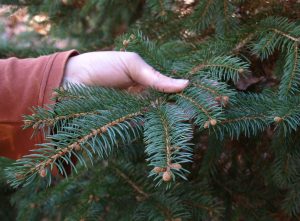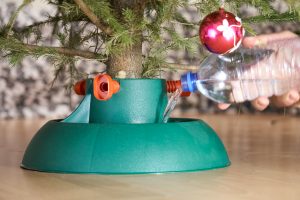What to know when getting a fresh Christmas tree
December 1, 2021
Remember to bring the proper equipment for getting your tree home, whether securing it to the roof of your vehicle or making room in the back. Many places will offer baling services to make it easier to transport. (Photo UC Division of Agriculture and Natural Resources)
If you have never purchased and set up a real, live Christmas tree, but are considering it because you’re thinking “green,” you are not alone. Tree growers are seeing more interest in real trees. However, before you buy, you should think about how you are going to set up and care for that tree — and about how you will dispose of it.
Be careful when you choose your tree size. Trees standing in a field, on display in a barn, or standing outside may not appear large because of the open environment—and that can fool you. Once brought inside, what appeared to be a medium-sized tree may occupy considerable space. Large trees are also more difficult to handle and set up. If you have a location in mind, measure the dimensions of the area before measuring and choosing a tree.
Don’t forget to measure the width of your prospective tree as well as the height. Some trees are more globose at the bottom and, thus, take more room than a tree with a steep taper. For your first real tree, a six- to eight-foot height may be appropriate.
Selection and Purchase
Locally produced, real trees are commonly sold by choose-and-cut farms. Procedures vary greatly from farm to farm, but in general, you’ll probably arrive and either walk or ride to the field and select the tree you want. You then cut the tree — or an attendant cuts the tree for you — and the tree is transported back to the central location.

When choosing a real Christmas tree, note that the needles should be fresh and flexible and should not come off. (Photo courtesy of the Clemson University Cooperative Extension)
At many farms, attendants shake the dead needles from the tree. This is especially important for species like Scotch pine. Depending on species and age, the inner needles in conifers naturally die. With short-needled trees, such as firs, most of the needles drop to the ground.
However, with long-needled trees, such as Scotch pines, the needles become lodged in the branches and, if not removed, continue to fall out during transportation, set up, and subsequent disposal. Shaking the tree eliminates any messiness at set-up.
Another service offered by some farms is tree baling. This is particularly important for larger trees. The tree is simply pulled through a cone-shaped device that applies netting or twine. By baling, most trees can be condensed to less than two feet in diameter without damaging the Another service offered by some farms is tree baling. As a result, these baled trees can be easily placed in a car trunk or tied on top of the car and subsequently moved through a door and into the house. The netting can be left on the tree until after it is placed in a stand. This makes it much easier to set up the tree. (NOTE: If you plan to leave the netting on the tree until after it is set up, be sure to flag the best side of the tree before it gets baled, so you can properly position it in the room.)
You can also buy real trees from lots set up for just a few weeks to accommodate seasonal demand. Many fulltime retailers such as hardware stores, grocery stores, and big box stores also sell real Christmas trees. These trees are precut, baled, and shipped to the point of final sale. Since the trees are precut, take care to make sure your tree is fresh, so that after you set it up, it will last for the holiday season.
Caring for your tree
Selecting a live Christmas tree is a tradition for many families. Whether you get your tree from a retail lot, direct from the farm or cut your own here are some tips for keeping your tree looking great throughout the holiday season:

Trim the base of your tree with 1/2-inch cut on the end before placing in the stand. Then maintain watering throughout the holidays to keep it fresh.
- After purchasing your tree, place it in an unheated garage or some other area out of the wind and cold (freezing) temperatures until you’re ready to bring it indoors. Make a fresh 1/2-inch cut on the butt end and place the tree in a bucket of water. Monitor the water level and add water as needed. If the tree is not taking up water, make a fresh cut.
- When making fresh cuts to your tree, make sure they are perpendicular to the stem (cut straight across). Cutting the stem at an angle or in a v-shape makes the tree less stable in the stand and can also reduce the amount of water that is available for your tree (some of the cut area may end up out of the water as the water level drops).
- When you decide to bring the tree indoors, make another fresh 1/2-inch cut and place the tree in a sturdy stand. The stand should be able to hold at least 1 quart of water per inch of stem diameter. For most Christmas trees that should be at least 1 gallon of water.
- Additionally, make sure your stand is big enough to fit your tree in. If you have to whittle down the sides of the trunk, your stand is too small. The outer layers of wood take up most of the water, and if removed it can greatly reduce the amount of water your tree can take up.
- Check the water level in your tree stand daily and keep it above the base of the tree. A cut tree will absorb a surprising amount of water, particularly during the first week, so it may need to be replenished daily. If the base dries out, resin will form over the cut end and the tree will not be able to absorb water and will dry out quickly.
- Commercially prepared mixes and additives such as floral and tree preservatives, molasses, sugar, bleach, soft drinks, aspirin, or any other concoctions you may find to add to the water are not necessary. Research has shown that plain water will keep a tree fresh. Adding water-holding gels is also not beneficial and can actually reduce the amount of water that is available for the tree.
- Keep the tree as far away as possible from heat sources such as heaters, vents, radiators, fireplaces, and direct sunlight. Keeping the room where the tree is located cool will also slow down the drying process.
- When it comes to decorating, make sure to check all Christmas tree lights for worn electrical cords. Also, be sure to turn off the tree lights when leaving the house and when going to bed.
- Many fresh-cut trees, if properly cared for, will last for three to four weeks before drying out. Run your hand through the needles to see if they are dry and brittle. If the needles easily break or fall off in your hand, your tree is dry and should be removed from the house.
Good Growing Tip: When it comes time to get rid of your Christmas tree instead of throwing it away or having the city come and pick it up, repurpose it. You can use it to help feed birds, provide habitat for wildlife, use the boughs as mulch, or use the needles as potpourri.
Daniel Cassens, Department of Forestry, Purdue U. Extension Services and Ken Johnson, horticulture educator University of Illinois Extension Services







